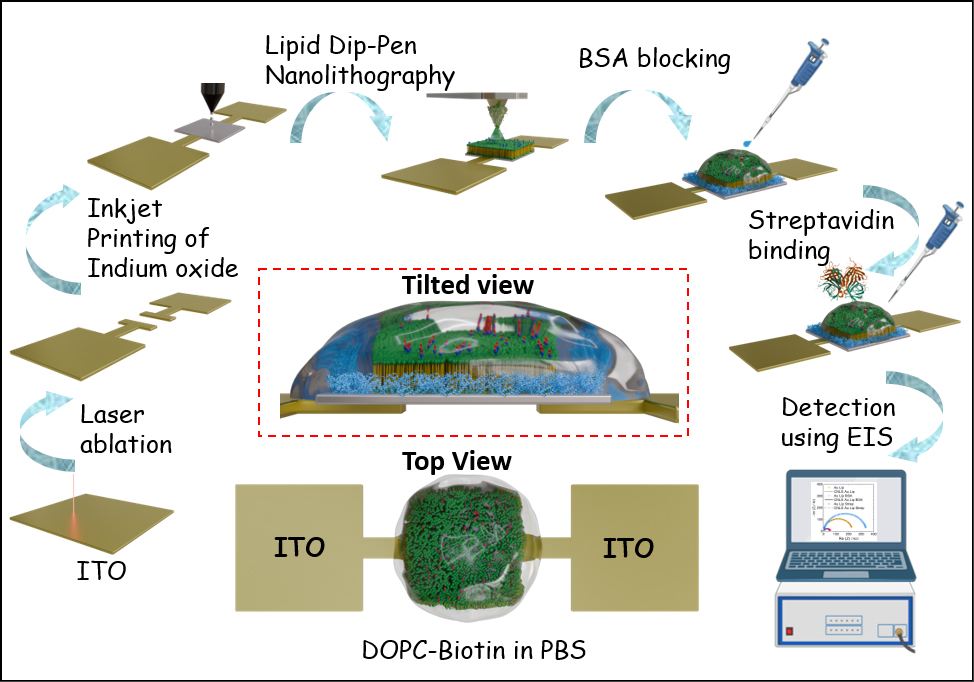
A Printed Phospholipid-Based Hybrid Biosensor with Impedimetric Readout
-
Author:
Srivatsan K. Vasantham
-
Source:
Dissertation, Karlsruher Institut für Technologie (KIT) (2025)
- Date: 2025
-
Phospholipids, as integral components of cell membranes, play a pivotal role in various biological processes, including their potential use as biomimetic materials. These amphiphilic molecules not only serve as structural "cushions" for presenting antigens on surfaces but also hold promise for studying cell-like behaviour. Their unique physicochemical properties such as dielectric nature, surface charge and electrochemical stability make phospholipids highly suitable for exploring material interactions and investigating substrates that could serve as advanced electrode materials in biosensor applications. The quest to identify advanced electronic materials suitable for electrode applications has spotlighted nanoglasses, particularly CuZr-based compositions, as promising candidates due to the ability to tailor the surface characteristics such as morphology and grain size to increase the electrochemical performance. However, substantial knowledge gaps persist regarding the complex interactions between phospholipids, cellular membranes, and these emerging materials, particularly in the context of biointerfaces and biosensing applications.
This dissertation explores these facets through two interrelated studies. In the first study, we examine the interaction of nanoglass surfaces with a phospholipid mixture comprising 1,2-dioleoyl-sn-glycero-3-phosphocholine (DOPC) and 1-palmitoyl-2-oleoyl-sn-glycero-3-phospho-L-serine (POPS), which are fundamental components of cellular membranes. Utilizing lipid dip-pen nanolithography, we observe a unique stabilizing effect of nanoglasses on lipid nanostructures, characterized by their ability to constrain lipid spreading on the surface—a phenomenon we term "confinement." This stabilization highlights a potential mechanism by which nanoglasses modulate cell membrane structure and, consequently, cellular behaviour. Such insights pave the way for understanding how nanoglasses influence cell-material interactions and hold promise for their application in biomimetic systems.
The second study emphasizes the development of a low-volume impedimetric biosensor, designed to minimize analyte consumption by utilizing sample volumes as small as 10 µl, while also requiring reduced material input. he sensor capitalizes on the unique electrochemical properties of an indium oxide (In₂O₃)/lipid interface, employing this composite as an efficient transducer material. This device is termed a hybrid biosensor, as it integrates an organic molecular layer-biotinylated DOPC phospholipids—with an inorganic metal-oxide semiconductor, indium oxide, thereby combining the strengths of both material classes. Fabricated through inkjet printing and functionalized with biotinylated DOPC phospholipids using dip-pen nanolithography, this sensor demonstrates exceptional sensitivity and scalability. The biosensor is optimized for the detection of streptavidin, with the electrochemical impedance spectroscopy (EIS) technique employed to monitor binding events. Substantial variations in leak resistance (Rleak) and surface capacitance upon target interaction show the sensor's capability for precise detection. The In₂O₃-based platform exhibits superior performance compared to conventional electrode materials such as gold, highlighting its potential to be used in multiplexed biosensing applications and point-of-care diagnostics.
Together, these two studies bridge critical knowledge gaps by elucidating the interactions between phospholipids and emerging material systems, such as nanoglasses and semiconductor-based electrodes. This work not only contributes to the understanding of phospholipid-material dynamics but also underscores the potential of advanced materials in biosensing technologies. By combining biomimetic lipid systems with innovative materials like CuZr nanoglasses and indium oxide, this research lays the groundwork for future advancements in biointerface design and biosensor development.
